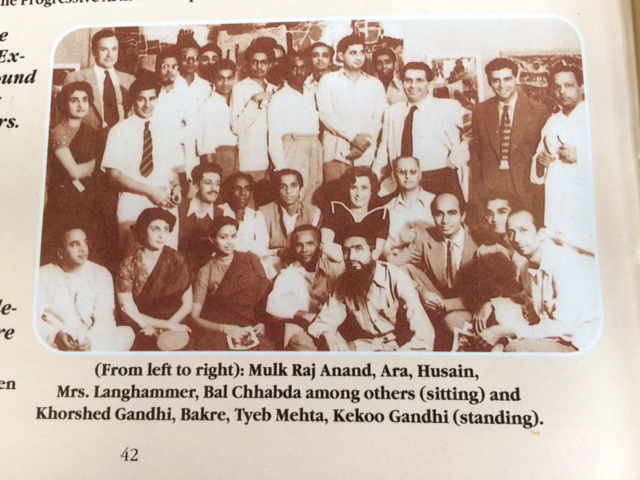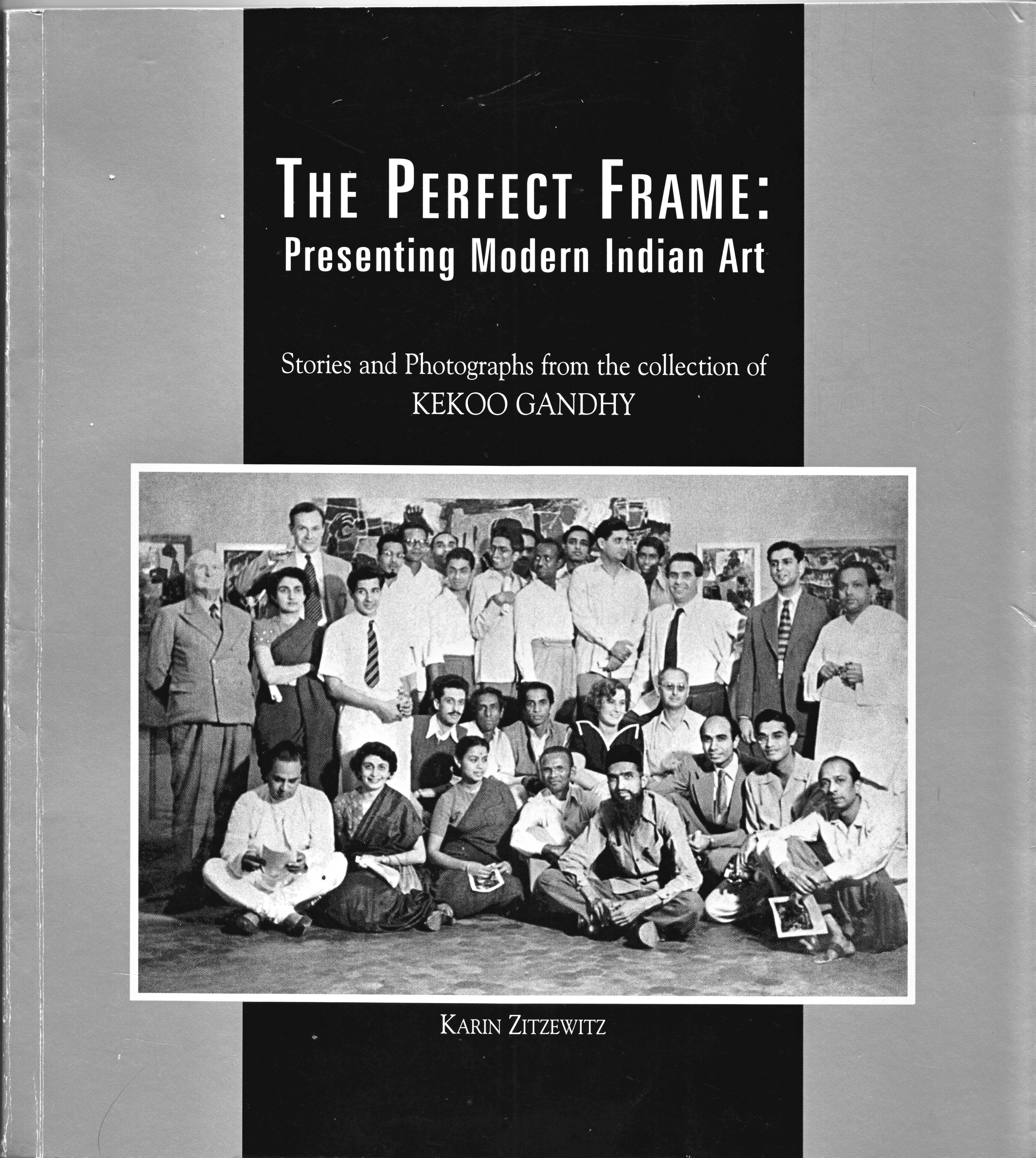Archive
Iconic Photo of the Progressive Artists’ Group and Their Associates
- Photograph
Iconic Photo of the Progressive Artists’ Group and Their Associates
Word Count: 10
- Bombay Art Society
- 1950
National Gallery of Modern Art (NGMA) Mumbai, Sir Cowasji Jehangir Public Hall, Mahatma Gandhi Road, Fort, Mumbai (Photo exhibited, first published 1996); Bombay Art Society Salon, (Ador House) 6 Rampart Row, Kala Ghoda, Bombay (6, K Dubash Marg, Kala Ghoda, Fort, Mumbai (Photo taken, 1950).
National Gallery of Modern Art (NGMA), Mumbai
- Mumbai (IN)
There are two versions of the PAG photo at the opening of M.F. Husain's first solo exhibition in 1950 (published in 1996 and 2003) and two narratives about the opening.
Word Count: 28

The iconic photo of the Progressive Artists’ Group and their associates, 1950 (Digital Photo Archive Margit Franz © Gandhy Archive, Mumbai; All Rights Reserved). First row: (seated, from left) Dr. Mulk Raj Anand, Siloo Bharucha, Renu Khanna, K.H. Ara, M.F. Husain (in black headgear, seated in front of everyone else), Bal Chhabda, unknown, G.M. Hazarnis (holding folder). Second row: (seated, from left) unknown, unknown, Laxman Pai, Käthe Langhammer (black dress with white framed collar), Emanuel Schlesinger. Third row: (standing, from left) Dr. Percy Brown, Khorshed Gandhy, T.A. Schinzel (behind Mrs. Gandhy), Krishen Khanna (in striped tie), Sadanand Bakre (with glasses, just behind Khanna), D.G. Kulkarni (with glasses, near Bakre), V.S. Gaitonde (to Kulkarni’s left), A.A. Amelkar, Tyeb Mehta, Shiavax Chavda (with hands folded), Walter Langhammer (in dark tie), Kekoo Gandhy, Manishi Dey. Last row: (standing) all four men are unknown. 
First publication of the iconic photo of the Progressive Artists’ Group and their associates in the catalogue for the inauguration of the National Gallery of Modern Art (NGMA) Mumbai, 1996 (Photo: Yashodhara Dalmia, 2020). 
Another moment from the same lineup: the historic snapshot from Khorshed and Kekoo Gandhy’s archive on the front-page of their book The Perfect Frame. Presenting Modern Indian Art. Stories and Photographs from the collection of Kekoo Gandhy (Zitzewitz 2003, front page). 
Dr. Percy Brown, Käthe Langhammer and M.F. Husain in front of Husain´s ground-breaking painting Man during the evening of the opening on 3 February 1950 (Dalmia 2001, 103; authorized by Yashodhara Dalmia). Anonymous. “Art Exhibition.” The Times of India, 8 September 1950, p. 7.
Anonymous. “Homogeneity in Art.” The Times of India, February 4, 1950, p. 8.
Bhagwat, Nalini. “Development of Contemporary Art in Western India.” (Doctoral thesis Maharaja Sayajirao University of Baroda, 1983), hdl.handle.net/10603/59326. Accessed 9 April 2021.
Dalmia, Yashodhara. The Making of Modern Indian Art: The Progressives. Oxford University Press, 2001.
Dalmia, Yashodhara. “The Rise of Modern Art and the Progressives.” The Progressive Revolution. Modern Art for a New India, edited by Zehra Jumabhoy and Boon Hui Tan, exh. cat. Asia Society Museum, New York, 2018, pp. 29–39.
Dalmia, Yashodhara. “Re: Kaethe Langhammer.” Received by Margit Franz, 30 March 2020.
Dalmia, Yashodhara. “Photo.” Received by Margit Franz, 3 April 2020.
Franz, Margit. “From Dinner Parties to Galleries: The Langhammer-Leyden-Schlesinger Circle in Bombay – 1940s through the 1950s.” Arrival Cities. Migrating Artists and New Metropolitan Topographies in the 20th Century, edited by Burcu Dogramaci et al., Leuven University Press, 2020, pp. 73–90. Project Muse, doi: 10.1353/book.77990. Accessed 30 March 2021.
Franz, Margit. “Die multiplen Identitäten und Loyalitäten der Käthe Langhammer.” Das Exil von Frauen. Historische Perspektive und Gegenwart (biografiA. Neue Ergebnisse der Frauenbiografieforschung, 26), edited by Ilse Korotin and Ursula Stern, Praesens Verlag, 2020, pp. 148–167.
Ganguly, Nanak. “Progressive Art Group Show: The Moderns. Revisited.” art etc. news & views, February 2012, www.artnewsnviews.com/view-article.php?article=progressive-art-group-show-the-moderns&iid=30&articleid=837. Accessed 5 April 2021.
Mumbai Modern: Progressive Artistsʼ Group 1947–2013, edited by Kishore Singh, exh. cat., Delhi Art Gallery, New Delhi, 2013.
Sharpe, Gemma. “Maqbool Fida Husain. Man.” Postwar at Haus der Kunst, postwar.hausderkunst.de/en/artworks-artists/artworks/man-mann. Accessed 8 April 2021.
Vajpeyi, Ashok, and Shruthi Issac, editors. Geyers: Letters Between Raza & Akbar Padamsee, Bal Chhabda, E. Schlesinger, F.N. Souza, Laxman Pai, M.F. Husain, R.V. Leyden, S.K. Bakre, Tyeb Mehta, V.S. Gaitonde, Ram Kumar, Walter Longhammar (Raza correspondence, vol 2). Vadehra Art Gallery, n.d. [2013].
Zitzewitz, Karin. The Perfect Frame: Presenting Modern Indian Art. Stories and Photographs from the Collection of Kekoo Gandhy. Chemould Publications and Arts, 2003.
Word Count: 320
Archival records from personal interviews between the author and Khorshed and Kekoo Gandhy, Mumbai, 30 April to 3 May 2003; 18 to 22 January 2004; 26 April to 12 May 2007; 13 to 15 October 2008; 24 October 2010.
Archival records from a personal interview between Yashodhara Dalmia and Maseeh Rahman and Käthe Langhammer, London, August 1993 (Digital Private Archive Margit Franz).
Private Archive Margit Franz, Sinabelkirchen.
Private Archive of late Khorshed & Kekoo Gandhy, Mumbai.Word Count: 62
- Bombay
- Margit Franz. "Iconic Photo of the Progressive Artists’ Group and Their Associates." METROMOD Archive, 2021, https://archive.metromod.net/viewer.p/69/2951/object/5140-11941873, last modified: 14-09-2021.
-
Mulk Raj AnandWriterPhilosopherArt PatronCultural CriticBombay
As a global socialist and modernist, Mulk Raj Anand sought and shaped opportunities for intellectual exchanges between Asia and Europe.
Word Count: 20
Kekoo Minochair GandhyFrame Shop OwnerGalleristArt CollectorBombayStarting from a cosmopolitan milieu for young local artists, Kekoo and his wife Khorshed Gandhy developed a business model that turned the frame shop into Gallery Chemould.
Word Count: 27
Rudolf von LeydenGeologistAdvertisement SpecialistJournalistArt CriticArt CollectorCartoonistBombayThe advertisement expert, Rudolf von Leyden, became a major art critic and art historian in Bombay in the 1940s, advocating an urgent need for modernism in art in post-colonial India.
Word Count: 30
Hilde HolgerChoreographerDancerTeacherBombayHilde Holger brought her expressionist dance practice from Vienna to Bombay, collaborating with local and exile artists, and opening a dance school.
Word Count: 22
Charles PetrasJournalistDirectorLanguage TeacherWriterTheatre MakerArt ManagerTranslatorBombayCharles Petras was the founder and director of the international cultural centre Institute of Foreign Languages, an avant-garde theatre director and a very active promoter of international understanding and world peace.
Word Count: 31
Marg. A Magazine of Architecture and ArtMagazineBombayLocal and exiled creatives formed the Modern Architectural Research Group to publish a progressive journal of art and architecture in Bombay from 1946 onwards.
Word Count: 23
Picture of Rudi von Leyden’ s Bust by Sadanand K. BakrePhotographBombayThe picture of the previously lost and recently located sculpture by Sadanand K. Bakre reflects the relationship between the artist Bakre and the art critic Rudi von Leyden.
Word Count: 28
One Man exhibition and subsequent trial, Akbar PadamseeCourt CaseBombayAkbar Padamsee’s solo exhibition in Bombay in 1954 was overshadowed by his arrest on charge of displaying obscene pictures. The subsequent court case drew support from across the art world.
Word Count: 30
Open Studio Evenings by Käthe and Walter LanghammerSalonBombayThe painter Walter Langhammer and his wife Käthe built an informal infrastructure to promote local avant-garde artists and regularly invited them to Open Studio Evenings at their studio.
Word Count: 29
TIFRUniversity / Higher Education Institute / Research InstituteBombayThe TIFR is one of India’s premier scientific institutions. Inside its buildings, scientists ponder over path-breaking ideas. Also, within its hallowed walls is a fine collection of modern Indian art.
Word Count: 31
Institute of Foreign LanguagesLanguage SchoolExhibition SpaceLibraryTheatreBombayWith its wide range of cultural activities, the Institute of Foreign Languages − founded in 1946 by the Viennese emigrant Charles Petras − became a glocal contact zone in Bombay.
Word Count: 27
Bombay Art SocietyAssociationBombayOne of the oldest art societies in India founded by colonial rulers, Bombay Art Society showcased art students and professional artists from all over India, including the Progressive Artists of Bombay.
Word Count: 31
ChemouldGalleryFrame ShopBombayChemould’s history stretches from its beginnings as a manufacturer of chemical mouldings and frames in 1941 over to a hub for art circulation displaying a variety of artists in Bombay.
Word Count: 30
Emanuel SchlesingerFactory OwnerTechnical DirectorArt CollectorArt CriticBombayThe art collector Schlesinger provided primarily financial aid by creating working opportunities for young artists in post-independence Bombay, and initiated the corporate culture of buying art.
Word Count: 26